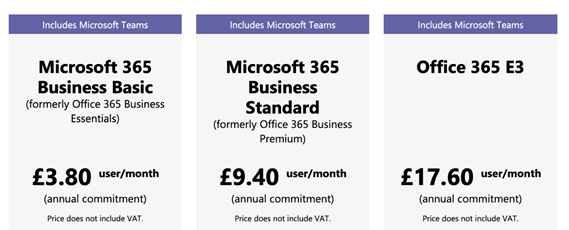
Executive Summary
- Digital collaboration tools have become commonplace in the UK since the global changes of 2020 altered the way we do our jobs.
- In this showdown, we’ll explore three of the most popular options and explain how they could help your business work smarter remotely.
- We’ll go in-depth on Microsoft Teams, Cisco Webex, and Zoom.
Introduction
It’s fair to say that the world of work has gone through a few changes during 2020.
But that doesn’t mean they’re all for the worst.
In fact, the mandatory large-scale experiment into working from home has been a roaring success for many companies.
If you’re a business who’s made the switch to WFH recently, you’ve probably already been somewhat confused by the deluge of digital tools available for working remotely.
(Don’t worry, we have too).
With that in mind, we’ve picked out three of the most popular digital collaboration tools and we’re going to give you the inside track.
Microsoft Teams, Cisco Webex, and Zoom: it’s time for a showdown.
Microsoft Teams
We’ll begin with one of the rising stars of 2020: Microsoft Teams.
Originally launched in March 2017, Microsoft Teams actually has roots in an entirely different app: Skype for Business. In 2016, when Microsoft decided not to make a bid for the chat platform Slack, they instead doubled-down on Skype, and the result – funnily enough – was Microsoft Teams.
It was a good move, too – because Microsoft reports 20 million active users as of November 2019. With the huge changes in working culture during 2020, that number is now likely much higher.
Built on the infrastructure of Microsoft 365, Teams is a collaboration platform through and through. It has built-in tools for chat, voice calls, meetings, workspace collaboration, and more. Users can add as many ‘Teams’ as they like, then create channels within these for specific groups, projects, and so on.
What are the key features of Microsoft Teams?
Short on time? Here are the highlights of the Microsoft Teams feature set.
- Online meetings, text chat, video conferencing, screen sharing, file sharing, and more.
- The ability to add Teams (e.g. Marketing, Sales, etc.) and then channels within those Teams (for specific projects).
- Online video meetings, from 1-on-1 calls all the way up to events hosting 10,000 people.
- Deep integration with Microsoft Office cloud apps, meaning users can all view and edit single documents together – without leaving Microsoft Teams.
- The option to share files, images, GIFs, videos and more within Teams and Channels.
- Available on multiple devices including Windows, Mac, iOS, and Android.
How much does Microsoft Teams cost?
As we’ve talked about before on the Get Support blog, Microsoft Teams is now an integral part of the Microsoft 365 suite of apps and cloud services.
For business users, it’s available starting at just £3.80 per user per month, and you get access to a host of other stuff too – including cloud-based versions of the Microsoft Office apps, SharePoint, OneDrive, and much more.
If you’re interested in Microsoft Teams, or 365 in general, the team at Get Support can help. As a Direct Microsoft Cloud Solutions Provider, we can cut out the middleman and get you the very best deal. Get in touch today to learn more.

Image credit: Microsoft.com
Cisco Webex
Webex (formerly stylized as WebEx) is a bit of a sleeping giant.
First founded during the golden age of home computing, back in 1995, Webex is one of the oldest tech companies in existence. And while it has a storied history, it’s never quite hit the mainstream – but that doesn’t mean it’s not a useful tool for businesses.
Webex was acquired by Cisco Systems in 2007, (for the princely sum of $3.2 billion), and has since been mainly focused on developing web and video conferencing tools.
While it may have started out a technical solution for screenshare-based webinars, Cisco Webex is now a fully-fledged suite of collaborative digital tools – much like Microsoft Teams.
In fact, even the naming is similar, with Webex Teams being its direct competitor and offering comparable services including chat, meetings, and file sharing.
What are the key features of Cisco Webex?
Want to know what else Cisco Webex has to offer? Here are the big-hitters:
- Webex Teams offers one-on-one text chat, video calls and meetings, and file sharing within the app.
- Offers a real-time whiteboarding app as part of Webex Teams, meaning colleagues can draw on any device and share it with everyone.
- Also includes access to Webex Meetings and Webex Events for meeting with people remotely on a larger scale.
- The ability to deliver customer support remotely with Webex Support.
- Webex Teams and Webex Meetings are available on Windows, Mac, iOS, and Android.
How much does Cisco Webex cost?
Cisco Webex operates a tiered pricing structure, with different apps within the suite available for different prices. It also has a free tier for personal users, which limits the amount of time which can be spent on calls (and a few more things, too).
For most business users who require multiple hosts, the ‘Plus’ package will be the minimum requirement, ringing up the till at £14.85 per user per month.

Image credit: webex.com
Zoom
If you’ve been working from home during 2020, it’s very unlikely that you’re not already familiar with Zoom.
A pureplay video conferencing service, even the word ‘Zoom’ has now become synonymous with online video calls. But how does it stack up against other digital collaboration tools?
The truth is that, if you’re looking for an all-in-one solution for a digital productivity tool, Zoom only really checks one of the boxes you need: video conferencing. While it does also offer a new text communication feature in the form of Zoom Chat, its most developed areas are video calls, webinars, and bringing people together to meet online.
What are the key features of Zoom?
Here’s what you’ll get if you choose Zoom as your digital workplace platform:
- Create and host online meetings with HD video, audio, and chat accessible during the meeting.
- Use the Zoom Rooms feature to tie a physical meeting room in your office to a virtual one anyone can join. (Note that an additional subscription is required for this).
- Host and record Zoom webinars which can be streamed live or distributed later.
- The new Zoom Chat client can be used to create persistent chat rooms between colleagues.
How much does Zoom cost?
As with the other platforms we’ve looked at, Zoom offers a free tier for personal users, but for business users who require multiple hosts, prices start at £11.99 per user per month.

Image credit: Zoom.us
How does your team like to collaborate?
We hope our showdown has helped shed some light on the intricacies of each of these platforms, and how their feature sets might work for your particular business. Naturally, the right choice for you will depend on your team, your workflows, and how you work.
Want more expert advice on the best digital tools for working in 2020?
At Get Support, we’re the IT experts. Call our friendly team now on 01865 59 4000 and we’ll answer any questions you might have, make recommendations, and more – all in easy-to-understand plain English.



